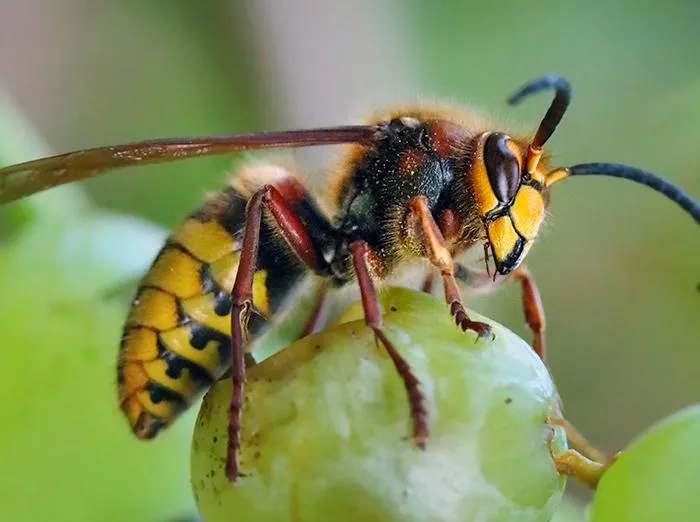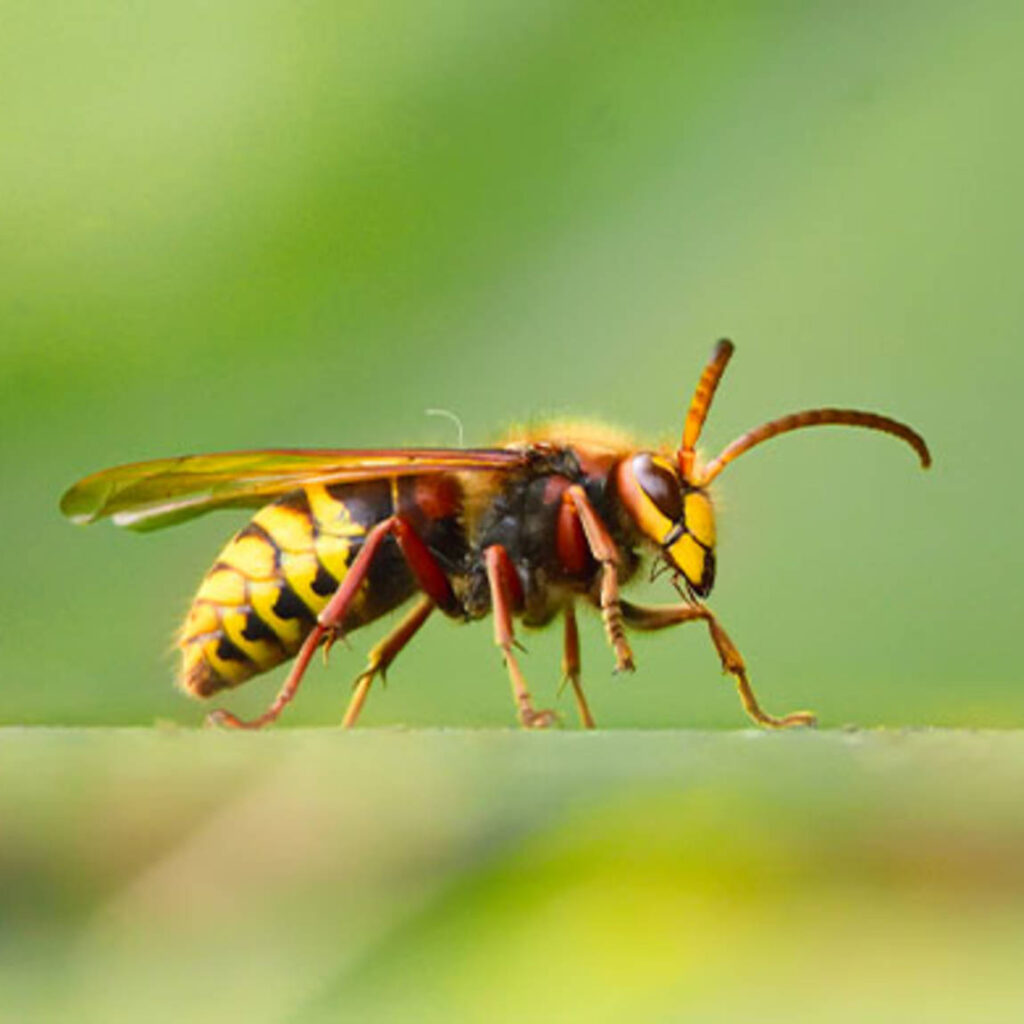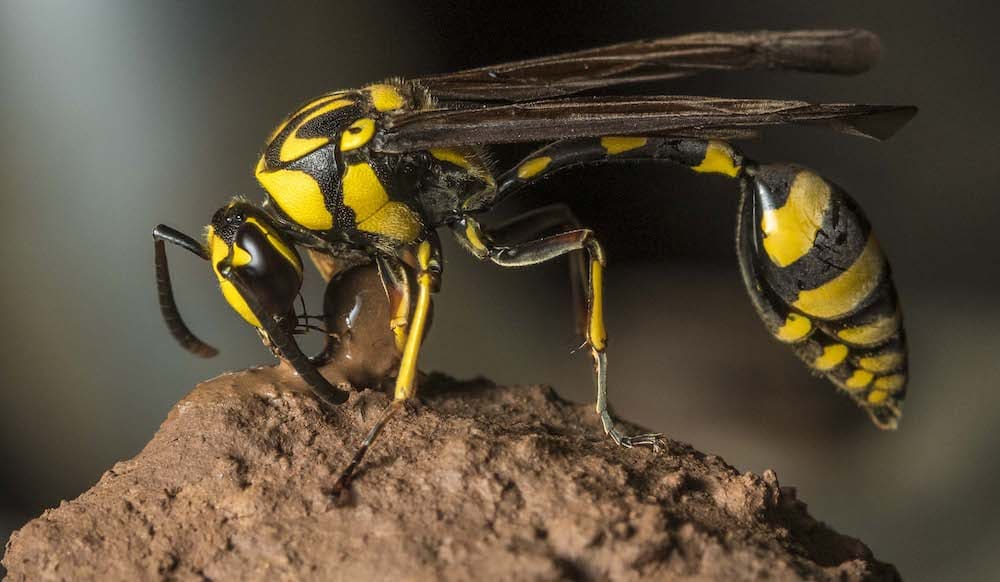Wasps/ Yellowjackets
- Check below to learn about the different species of stinging pests commonly found in the Post Falls and Spokane area.
Have a Question About Stinging Pests?

Hi! We’re Brock and Blake, your neighbors. We own Spud Pest Control. If you have a question about a pest use the buttons below to call or text us!
- Check below to learn about the different species of stinging pests commonly found in the Post Falls and Spokane area.
Common Stinging Pests In The Post Falls and Spokane Area
Did you know? Wasps can sting multiple times without dying, unlike bees, which can only sting once before they perish. Additionally, when threatened, wasps release a chemical that signals other wasps to join the attack in defense of their nest. Social wasps build their nests out of a paper-like material created from chewed-up wood fibers mixed with saliva. These nests are often found hanging from trees or under eaves, with some species constructing large, complex structures containing hundreds of individual cells.


Paper Wasps
- Color: Reddish – Black
- Size: ½ – ¾ Inch
- Location: Trees/Houses
Paper wasps are typically ½ – ¾ inch long, with a slender body, reddish-brown or black coloration, and yellow markings on their abdomen. Their long, thin legs often extend outward from their bodies as they fly. They are less aggressive than yellowjackets but will sting if provoked. Paper wasps build distinctive papery nests that hang under eaves, tree branches, or in sheltered spots. Their nests are umbrella-shaped with open cells that are visible from the outside. These wasps are generally beneficial, as they prey on other insects.


Yellowjackets
- Color: Yellow & Black Strips
- Size: ½ – 1 Inch
- Location: Trees/Ground/Houses
Yellowjackets are about ½ – 1 inch in length, with a distinctive yellow and black striped pattern. They have smooth, shiny abdomens and a more aggressive nature compared to other wasps. Yellowjackets are often seen near food sources, trash, or around outdoor activities in late summer and fall. They build nests in the ground, under rocks, or in wall voids, often near human habitation. These insects can sting multiple times and are particularly active around food during late summer.


Hornets
- Color: Black & White/Yellow
- Size: 1 – 1.5 Inches
- Location: Trees/Houses
Hornets are large wasps, typically 1 to 1.5 inches long, with a robust body and distinct black and white or yellowish markings. They are typically darker in color compared to yellowjackets and have a more powerful sting. Hornets tend to be more aggressive than paper wasps or honey bees, especially if their nest is disturbed. Hornets build large, football-shaped nests made from a papery substance, often in trees, shrubs, attics, or under the eaves of buildings. They often build their nests high up, in sheltered spots, and are most active during late summer and early fall.


Honey Bees
- Color: Golden Brown (Fuzzy)
- Size: ⅝ Inch
- Location: Hollow Trees/Wall Voids
Honey bees are small, fuzzy insects that are about ⅝ inch long, with golden-brown bodies covered in fine hairs. Their abdomens are segmented with black bands. Honey bees are social insects that live in large colonies, often numbering in the thousands. They are most commonly found in gardens, orchards, or anywhere flowers are abundant. Honey bees build their hives in hollow trees, beehives, or wall voids in structures. They play a crucial role in pollination but will sting only in defense of their hive.


Carpenter Bees
- Color: Orangish – Black
- Size: ¾ – 1Inch
- Location: Sound Wood
Carpenter bees are large, ranging from ¾ inch to 1 inch long, with a round, shiny, black abdomen that is hairless. They are often mistaken for bumblebees, but they have smooth, shiny abdomens. While bumblebees are social, carpenter bees are solitary and nest in wooden structures, such as eaves, fences, decks, or trees. They bore round, clean holes into wood to create their nests, which can lead to structural damage over time. Though they are not aggressive, the females can sting if provoked, but their sting is usually mild.


Mud Daubers
- Color: Black – Blue
- Size: ¾ – 1 Inch
- Location: Shaded Areas
Mud daubers are smaller wasps, ranging from ¾ inch to 1 inch long, with long, slender bodies that are usually black or metallic blue. They are solitary and non-aggressive, and unlike other wasps, they do not form colonies. Mud daubers collect mud to create cylindrical nests, often on the sides of buildings, under eaves, or in corners. These wasps often build their nests in more isolated areas, such as barns or sheds, and they prey on spiders, which they paralyze and place in the mud nests for their larvae to feed on.


African Bees
- Color: Golden Brown (Fuzzy)
- Size: ⅝ Inch
- Location: Hollow Trees/Wall Voids
African bees, also known as Africanized honey bees, resemble honey bees in size (about ⅝ inch), with similar coloring and structure. However, they are more aggressive and tend to swarm more frequently when their hive is disturbed. African bees are often found in warmer climates and have spread throughout parts of the U.S., especially in the southern regions. They live in colonies like honey bees and are generally found in tree hollows, man-made hives, or even in abandoned buildings. While their sting is not more dangerous than that of a regular honey bee, their aggressive behavior can lead to multiple stings.
WASPS/ YELLOWJACKETS FAQ's
What is the difference between bees and wasps?
Bees are usually hairier and more focused on collecting pollen, while wasps are smoother and more aggressive.
Do wasps use the same nest each year?
No, typically a new nest is established every year. However old nests can then become homes to other types of insects.
How do I prevent wasps from building nests around my home?
One of the best ways to prevent wasps from forming on your home is to treat it with residual products. This way when a wasp lands there to start building they die off before they can.
What do wasps eat?
Wasps like a variety of different foods including insects, fruit, and nectar. Sometimes when those natural food sources become scarce they will turn more carnivorous.
What attracts wasps to my house?
Wasps are attracted to your home to feed on different food or water sources. To help reduce the amount of them, consider eliminating those sources.
How do I get rid of a wasp nest?
There are a few different ways to remove wasp nests. It can be done using liquid or dust pesticides. If nests are out of reach you can use a web pole to knock it down.
Why do wasps and bees sting?
Typically wasps and bees sting because they feel threatened or feel as though their nest is under attack.
